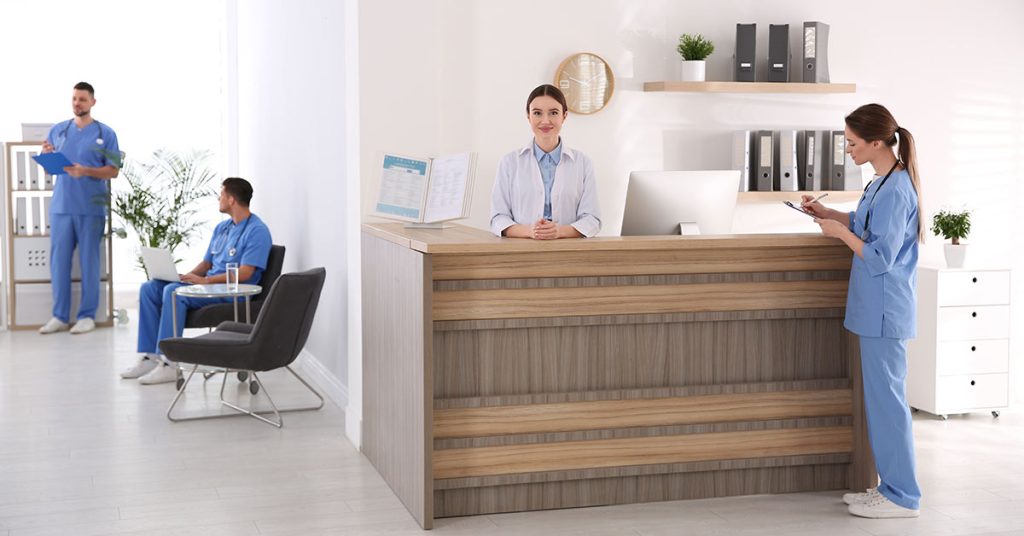Is Being a Medical Receptionist a Good Job? Salary Expectations, Career Growth, and Progression in Australia
Being a medical receptionist can be a highly rewarding and stable career choice, particularly for those interested in healthcare and administration. Medical receptionists play a crucial role in the smooth operation of medical practices, clinics, hospitals, and other healthcare facilities by handling administrative tasks and providing essential support to both medical professionals and patients. If you’re considering this career path in Australia, it’s important to understand the job’s expectations, salary potential, career growth opportunities, and the overall work environment. This article explores whether being a medical receptionist is a good job, along with salary expectations and opportunities for career progression in Australia.

Is Being a Medical Receptionist a Good Job?
1. Key Responsibilities of a Medical Receptionist
Before discussing salary expectations and career growth, it’s important to understand the core duties of a medical receptionist. These duties typically include:
- Patient Interaction: The medical receptionist is often the first point of contact for patients, whether in person, over the phone, or via email. They manage appointment bookings, greet patients, answer queries, and ensure that patients’ needs are met promptly and professionally.
- Managing Appointments and Scheduling: Medical receptionists coordinate appointments for doctors, specialists, or other healthcare professionals. They also manage cancellations and reschedules and ensure the doctor’s schedule is optimised.
- Patient Registration and Documentation: They are responsible for maintaining accurate patient records, ensuring patient information is up-to-date, and managing administrative duties such as insurance verification, billing, and handling medical histories.
- Handling Phone Calls and Queries: Receptionists answer incoming calls, direct patients to the appropriate department, and take messages for the medical staff. They also handle patient inquiries related to services, fees, or procedures.
- Maintaining Office Supplies and Cleanliness: Medical receptionists ensure that the waiting area is clean, stocked with necessary materials, and well-organised. They may also order office supplies and manage inventory.
2. Is it a good job?
Being a medical receptionist can be a good job for a number of reasons:

- Stability and Demand: Healthcare is one of the most essential industries, and medical receptionists are always in demand, particularly as the population ages and more people seek medical care. Hospitals, private practices, specialist clinics, and other healthcare facilities regularly require administrative support.
- Impact on Patient Care: Although medical receptionists may not directly provide medical care, they play a critical role in ensuring patients receive the necessary support and feel welcomed in the healthcare environment. Their work helps create a smooth patient experience, which can contribute to better overall care.
- Interaction with People: If you enjoy working with people and providing customer service, this role offers excellent opportunities for daily patient interaction. You will have the chance to build relationships with patients and contribute positively to their experience at the medical facility.
- Flexible Work Hours: Many medical receptionists in Australia work in environments that offer flexible hours, especially if employed at a general practice or specialist clinic. Some medical receptionists may work part-time or take shifts, making this role a good fit for those seeking a work-life balance.
- Opportunities for Growth: Although the role of a medical receptionist may start as an entry-level position, it offers opportunities to move up in the healthcare administrative field or branch into other areas such as medical office management, health administration, or billing and coding.
3. Salary Expectations for Medical Receptionists in Australia
Salaries for medical receptionists in Australia vary depending on factors such as experience, location, and the type of medical facility. Here are the general salary ranges:
- Entry-Level Salaries:
For those just starting out, medical receptionists can expect to earn around AUD 45,000 to AUD 55,000 annually. Entry-level salaries can be on the lower end, but experience and specialized skills can significantly increase earning potential. - Mid-Level Salaries:
With a few years of experience, medical receptionists can expect to earn between AUD 55,000 to AUD 65,000 annually. This may include responsibilities beyond standard receptionist duties, such as medical billing, data management, or supervising junior staff. - Senior-Level Salaries:
Experienced medical receptionists who take on more significant responsibilities, such as office management or supervising other administrative staff, can earn AUD 65,000 to AUD 75,000 or more per year. Specialisation in certain medical fields, such as radiology or dentistry, may also result in higher salaries. - Location Considerations:
Salaries can vary based on geographic location. Medical receptionists in larger metropolitan areas such as Sydney, Melbourne, or Brisbane may earn slightly higher salaries due to the higher cost of living. Conversely, those working in regional or rural areas may see slightly lower salaries but could receive additional benefits or incentives to work in less populated areas.
Read More:
4. Career Growth and Progression
One of the attractive aspects of becoming a medical receptionist is the potential for career growth and progression. Here are several ways to advance your career:

- Office Manager or Practice Manager:
Experienced medical receptionists can move into managerial roles, such as office manager or practice manager, where they are responsible for overseeing the day-to-day operations of a medical facility. These roles often involve more responsibility, including staff management, budgeting, and patient care coordination. - Medical Billing and Coding:
Medical receptionists with a background in administrative duties can transition into medical billing and coding, a specialised role in healthcare where professionals manage patient billing, insurance claims, and coding of medical procedures. Additional certifications in this area can lead to higher-paying opportunities. - Health Administration:
Medical receptionists with an interest in healthcare management and administration can pursue further education to transition into roles like health administrator or medical office administrator, overseeing the business side of healthcare facilities. Additional qualifications, such as a Certificate IV in Health Administration, may be required for this progression. - Specialised Roles in Larger Practices:
In larger medical practices or hospitals, medical receptionists may specialise in certain areas such as pharmacy, radiology, or oncology administration. Specialising in these areas can lead to higher-paying roles with increased responsibilities. - Further Education:
Many medical receptionists pursue further studies to expand their qualifications. Programmes such as the Certificate IV in Health Administration, Diploma of Practice Management, or Bachelor’s degree in Health Services Management can open up more advanced opportunities in healthcare administration.
5. Work Environment and Job Outlook
The healthcare industry in Australia is stable, with a growing demand for administrative support staff, including medical receptionists. The job outlook for medical receptionists is strong, as the need for medical professionals and their support staff continues to rise.
- Workplaces:
Medical receptionists are employed in a variety of healthcare settings, including private practices, hospitals, specialist clinics, and dental offices. They work in busy environments that require attention to detail, multitasking, and strong customer service skills. - Job Stability:
With an increasing population and a growing demand for healthcare services, medical receptionists in Australia benefit from job stability. Healthcare is one of the fastest-growing industries, providing ample opportunities for long-term employment. - Work-Life Balance:
Medical receptionists working in private practices or clinics often have fixed hours, allowing for better work-life balance. Those employed in hospitals or 24/7 facilities may need to work night shifts, weekends, or holiday hours, but this flexibility can be beneficial for those who prefer non-standard working hours.
Supplementary Considerations
6. Job Satisfaction
Job satisfaction for medical receptionists in Australia can be high, especially for those who enjoy working in a fast-paced environment, interacting with patients, and contributing to the smooth functioning of a healthcare facility. The opportunity to help patients, provide excellent customer service, and work alongside medical professionals is fulfilling for many in this role.
7. The Future of the Medical Receptionist Role
As healthcare technology advances, medical receptionists in Australia may see changes in their duties. Automation and digital systems are becoming more common in healthcare facilities, leading to more efficient appointment scheduling, electronic health records, and online billing systems. While this may change the way medical receptionists perform certain tasks, it also opens up opportunities for medical receptionists to specialise in technology-related areas, such as managing digital systems or electronic health records.
Conclusion
Being a medical receptionist in Australia can be a rewarding career for those who enjoy helping people, working in healthcare, and managing administrative tasks. With stable job prospects, opportunities for career growth, and competitive salaries, this role offers both personal and professional fulfillment. Whether you’re just starting your career or looking to advance, becoming a medical receptionist provides a solid foundation in the healthcare industry with numerous paths for progression.

